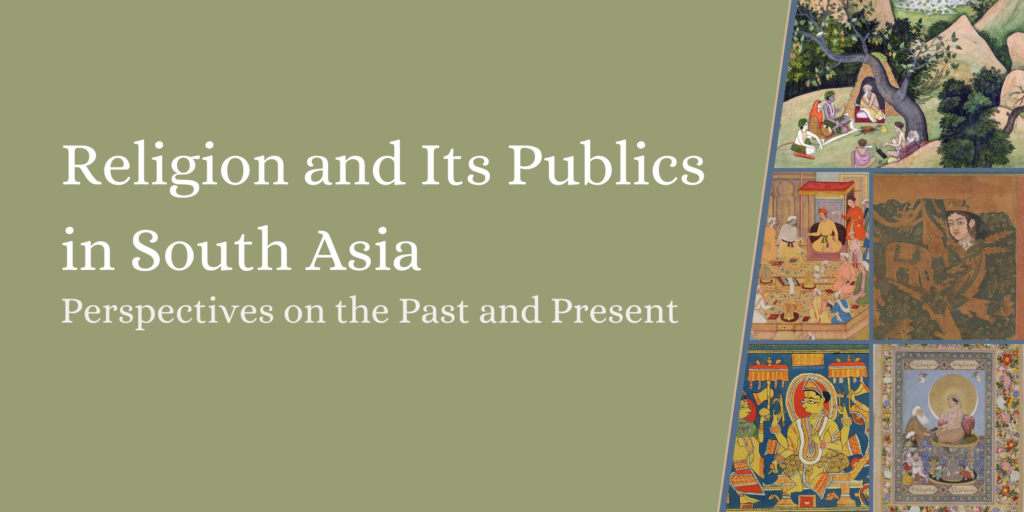
Image adapted from The Fabulous Creature Buraq by unknown author and a painting by Nar Singh (Public Domain)
A virtual conference sponsored by Canopy Forum and the Center for the Study of Law and Religion at Emory (CSLR) featuring scholars, experts and practitioners who will examine the many religious traditions of South Asia and their diverse publics. Participation by invitation only. View selected videos and browse all essays here.
“A Forgotten Chapter in the History of Hindu Law? James Henry Nelson and 19th Century Madras High Court Jurisprudence”

Geetanjali Srikantan
The conception of Hindu law often evokes two competing visions – the image of a millennia – old ancient law founded on Sanskrit texts known as the Vedas and their commentaries, as well as the body of modern Hindu law comprised of statutes and court judgments regulating inheritance, marriage, and succession of Hindus as a religious community. The reasons for such competing visions can be found in Indian legal history where the compulsions of governance led British colonial administrators in collaboration with native elites to produce Hindu law as a body of knowledge based on ancient Sanskrit texts but molded in a manner to fit the needs of modern legal governance. The borrowing of doctrines from English law, the dual influences of liberalism and capitalism, and the legal articulation of citizenship claims have been documented by various scholars including Rachel Sturman and Eleanor Newbigin. Legal scholars such as Flavia Agnes have documented the dominance of Brahmanical norms and rituals in the everyday practices of Hindu law, including marriage and divorce.
How did upper caste Brahmanical norms become entrenched in modern Hindu law? A textual understanding of religion led the British to perceive the Sanskrit texts as being the sources of Hinduism as a religion as well as the laws of the Hindus. In 1780, the Administration of Justice Regulation, initiated by Warren Hastings, provided that inheritance, marriage, caste, and other religious usages were to be administered by the laws to be found in Sanskrit texts monopolized by Brahmins. Through consultation with pundits who were native informants, a “code of Hindu law” was compiled, known as the Vivadarnavasetu, or A Code of Gentoo Laws by Nathaniel Halhed. This code was not considered adequate enough to meet the needs of common lawyers, and William Jones, an orientalist and judge at the Calcutta Supreme Court, set about remedying it with the collaboration of the pundits – the result being another treatise, Vivada-bhangarnava. This was still considered insufficient, and numerous textbooks on Hindu law and usages were compiled in the 19th century by authors such as Thomas Strange and John Mayne. Such textbooks became imperative due to the transfer of authority to the Crown after 1857 and the establishment of High Courts which led to the need for efficient legal administration. The relegation of Hindu law to the sphere of family law and the proliferation of enactments on property, contract, and other areas of law also made clarity in Hindu law essential.
The sources of Hindu law relied on by textbook writers and judges were constructed in a hierarchical manner with the Smritis (literature expounding the meaning of the Vedas) being the foremost source of law – the Manu Smriti being given the most importance (although other Smritis such as the Yagnavalkya Smriti also assumed importance) along with digests and commentaries. Schools of law (first propounded by Henry Thomas Colebrooke) known as Dayabhaga (the Bengal school) and Mitakshara (the Benares school but also the name of the commentary), based on two different commentators on the Smritis and applicable in different parts of India, became important in legal methodology. Decisions of colonial judges became authoritative due to the doctrine of precedent. This legacy of colonial law forms the basis for Hindu family law in India today.
How did colonial administrators address the incongruities in modernizing ancient laws? By using selective legal methodologies to generate a uniform law applicable to a majority of Indians who became identified as Hindus and as members of a religious community but merely reflected a minority elite class. The process of generating Hindu law was not without its controversies. Matters such as recognizing custom – who is a “Hindu” and to whom does the “Hindu law” apply to – and the identification of practices such as adoption or division of property were frequently debated.
However, the most serious challenge to the idea of Hindu law arose in a conflict between James Henry Nelson, a British colonial administrator in the Madras Civil Service, and Justice Lewis Charles Innes of the Madras High Court on the nature of Hindu law. Nelson argued that that there was no Hindu nation or people and that the Manu Smriti translated by William Jones could not be considered as a code of law to govern Hindus. He also argued that Tamils were not Hindus despite some of them adopting Brahmanical forms of worship and part of the Sanskrit law due to a large number of them following practices such as polyandry, widow remarriage, divorce, and “devil worship”.
These views were propounded in various works authored by Nelson titled A View of the Hindu Law as Administered by the High Court of Judicature at Madras, A Prospectus on the Scientific Study of Hindu Law, and Hindu Law at Madras, forming a sustained attack on the jurisprudence of the Madras High Court.
Why did Nelson think that Hindu law did not exist? His argument was both historical and jurisprudential. He challenged the historical basis of Hindu law by arguing that there was no integrity to the code of Manu due to the existence of different versions in South East Asia. He questioned whether written laws existed in the Indian subcontinent using historical accounts of travelers and based on the account of a Jesuit priest argued that no courts and maxims were used in place of written law. In arguing that the Mitakshara school did not apply to the Southern part of India, he drew attention to customary practices which were not in conformity with the law laid down by the Mitakshara.

His main line of argument lay in his fifteen false principles elaborately explained in his View of the Hindu Law. The first false principle was an attack on the idea of “schools of Hindu law” and that they were inapplicable in Southern India. The second false principle was that Hindu law was applicable to all persons identified as Hindu. The third false principle was that customs that were not judicially recognized could not prevail despite evidence of its practice over a long period of time. Other false principles involved doctrines around collective ownership in the institution of the Hindu joint family and adoption by widows. Nelson challenged the interpretation and applicability of Sanskrit texts and the usage of English doctrines such as equity in settling legal claims along with an analysis of judgments drawn mainly from the Madras High Court.
Nelson’s most provocative suggestion was that a Commission needed to be constituted to investigate how far Sanskrit law found acceptance within the population and that there must be an inquiry into the customs and usages of Indian castes. This should lead to a Code of Hindu law based on usages and customs to be followed by courts. He further argued that there should be separate legislation for non-Brahmin castes and legislation to allow Indians to assert customary practices against the general Hindu law.
Duncan Derrett, in a short biography of Nelson, comments that his failure to acknowledge Sanskrit texts when they supported his case did not lend his argument accuracy, especially when he had charged the High Court with misinterpreting these texts. This highlights the conundrum of using Sanskrit texts as codes of law to interpret the customs and practices of a varied population and the usage of interpretative methods from English common law to fulfill a larger objective, which is the production of family law as the law for a people identified as Hindus. As Duncan Kennedy has argued, family law as a category emerged in the nineteenth century. This was due to the family being perceived as a site of moral relations which developed a form distinctive to each nation. Kennedy specifically mentions the development of different personal laws for Hindu and Muslim religious communities by the British as an illustration.
The heated response to Nelson by Justice Innes in a letter addressed to Mounstuart Elphinstone Duff the Governor of Madras reflected the anxiety of producing a family law for the Hindu nation with the methodology of the common law. Using the concept of precedent in common law, Innes took a defensive position arguing that the Madras High Court had to follow the doctrines of Hindu law as laid down by the Privy Council in England. He defended the use of the Manu Smriti on the ground that this fitted the descriptions given of legal trials at that particular time and cited different interpretations of Sanskrit texts to counter Nelson’s arguments on the application of the Mitakshara. Among other reasons, the argument on the lack of a written law was countered with the fact that English law was also unwritten law. In regard to the call for a Commission, Innes asserted the results of an enquiry in Bombay among different castes showing that their practices were in conformity with principles of Hindu law, including adherence to Brahmanical worship, and also reiterated the need to ignore specific customs in favour of Hindu law due to the demands of practical administration.
In constructing the domain of family law, Innes dismissed the usage of ordeals as customary legal practices as a ground for the non-applicability of the Mitakshara, arguing that the Mitakshara is concerned only with family law and not with criminal law. This reasoning was used despite him admitting that the Mitakshara dealt with evidence and ordeals. He also argued that there were no treatises on family law in the Tamil language, which pointed to the probability of the Sanskrit texts being applicable. For Innes, the domain of family law had to be constructed in relation to property and the economy, and courts were not bound to implement the aspects of the Mitakshara that dealt with property but not succession. The jurisprudential issue raised by Nelson in relation to the adequate translation of concepts such as adoption or guardianship in Sanskrit terminology was ignored by Innes completely.
Although Nelson’s claims failed, this debate is important for its exposure of the jurisprudential basis of Hindu law. Although it can be argued that the Sanskritic basis of Hindu law provides for customs to be upheld and that there is statutory recognition of customs of different groups and castes in India, it does not take away the fact that such groups have to prove their identities. If history had been different and Nelson’s argument had been accepted, one may have had a more fractured Hindu law and a non-homogenous Hindu legal identity. This could have had consequences for Hindu political mobilization as well as movements to abolish personal laws through a uniform civil code. ♦
Geetanjali Srikantan is a legal historian with research and teaching expertise in legal history, comparative law and jurisprudence. She previously worked as an Assistant Professor of Global Legal History at Tilburg University and is the author of the book Identifying and Regulating Religion in India: Law, History and the Place of Worship published with Cambridge University Press in 2020.
Recommended Citation
Srikantan, Geetanjali. “A Forgotten Chapter in the History of Hindu Law? James Henry Nelson and 19th Century Madras High Court Jurisprudence.” Canopy Forum, March 10, 2022. https://canopyforum.org/2022/03/10/a-forgotten-chapter-in-the-history-of-hindu-law-james-henry-nelson-and-19th-century-madras-high-court-jurisprudence/.

